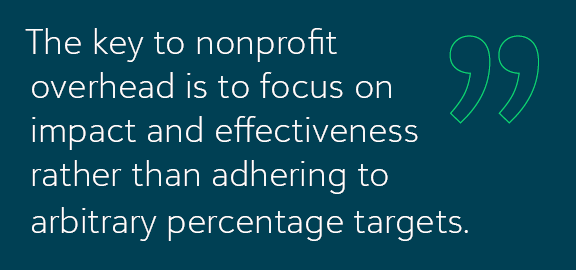Understanding Nonprofit Overhead: Strategies for Transparency and Efficiency in 2025

Most nonprofit finance teams have been taught to keep their overhead costs buried deep within their financial statements. But recent events and changing philosophies on overhead costs have shed light on these expenses, which are required to run a functioning nonprofit.
On the positive side, the U.S. Office of Management and Budget (OMB) revised their uniform guidance in 2024, increasing the de minimus (or standard) rate allowed for indirect costs—overhead for federal grants—from 10 to 15%. The Trust-Based Philanthropy movement and the documentary “Uncharitable” continue to encourage funders to understand the full picture of an organization—not just a single number like a nonprofit’s overhead ratio.
But overhead expenses have also been the focus of recent policy changes as well. The Department of Education capped indirect costs for research grants at 15%, regardless of the rates each grant had negotiated during the application process.
These changes make it more important than ever for nonprofit finance teams to understand your organization’s narrative on your overhead expenses. Overhead expenses are part of running your nonprofit, and knowing your ratio and the benchmarks for your organization type can help you have more informed discussions with your funders and donors.
What’s Included in Your Organization’s Overhead Expenses?
Your organization’s overhead expenses are any costs not specifically allocated toward a program. They are how you run your day-to-day operations.
On your form 990, you are required to break out your expenses into program, fundraising, management, and general. Both the IRS and FASB have guidance for these classifications. Typically, what’s included in your management, fundraising, and general expenses are considered your overhead.
Here are a few examples of categories that would fall into these buckets.
- Fundraising costs include any expenses related to seeking or soliciting donations, including the salary of your development staff, any fees associated with fundraising consultants, and costs to print your mailers.
- Management and General includes the admin costs, salaries, and stipends paid to the board of directors, leadership, and staff not directly related to specific programs, such as your finance team. It also includes any legal fees as well as insurance and general office management, like copy paper and ink for the printer. Your rent or mortgage payment and utilities are also considered management and general expenses.
Overhead vs Indirect Costs: What’s the Difference?
Indirect costs are the overhead expenses incurred as part of a government grant. If you are applying for federal funding, the OMB allows for the grant to pay up to 15% towards those costs not directly associated with the program, such as rent or support salaries. That’s often not enough to fully cover an organization’s costs, so many organizations solicit unrestricted funding from donors or private grants to fill the gap.
Organizations that have significant indirect costs and earn federal funding can negotiate a higher indirect cost rate, or Negotiated Indirect Cost Rate Agreement (NICRA), with their agency of record. For example, human services organizations that deliver a range of community-based services—housing assistance, mental health services, and workforce development—often require complex infrastructure for compliance, HR, and reporting. They often benefit from negotiating a higher indirect cost rate with the agency where they received the grant.
The Myth of the Ideal Overhead Ratio for Nonprofits
The idea that a smaller overhead ratio means an organization is more effective is untrue and damaging to organizations across impact areas. There is no ideal nonprofit overhead ratio—different types of organizations will require more overhead than others. And all organizations need to pay for utilities, salaries, and fundraising campaigns if they want to continue to work on their mission.
For example, a museum collection is expensive to maintain and grow, and those expenses flow into their admin costs. Compare that with a tutoring program that partners with a local library or a food pantry where most of the food is donated, and the museum’s overhead ratio will be significantly higher. Does that mean it’s less efficient? Not necessarily.
Keeping salaries of staff members so low that they are not competitive with similar for-profit roles means your current staff is more likely to struggle financially, and you won’t be able to attract and keep quality applicants.
The key is to focus on impact and effectiveness rather than adhering to arbitrary percentage targets.

Communicate Overhead with Clear Reporting
When presenting your financial statements, don’t hide your overhead expenses. Instead, focus on telling a story of effectiveness and impact.
Transparency is your greatest ally in building trust with your funders. Start by openly sharing your financial statements, including your organization’s IRS Form 990, on your website or other accessible platforms. This simple act invites your donors and funders to explore the details of your operations and demonstrates your commitment to accountability and clarity. If you think there is a line that may be misconstrued, such as executive salaries, provide benchmarks and highlight the impact those people have made on the organization.
Use your Statement of Functional Expense to break down program and overhead costs clearly. Regularly pulling these reports helps you segment your expenses with precision and provide a clear narrative about how funds are allocated. For example, highlighting the value of competitive salaries and benefits for your team can challenge misconceptions about overhead. Show how investing in your people is directly tied to your mission’s success, spotlighting their contributions as integral to driving impact.
Finally, shift the conversation from percentages to outcomes. Your story should focus on the effectiveness of your work, emphasizing how overhead investments—be it salaries, utilities, or fundraising initiatives—enable your organization to fulfill its mission more effectively. Use examples from your operations to illustrate how these expenses translate into tangible results, encouraging funders and donors to see overhead not as a burden but as a necessary ingredient for long-term impact. By embracing transparency and reframing the narrative, you can foster deeper connections and advocate for a more nuanced understanding of nonprofit sustainability.
Simplifying Cost Allocation with Fund Accounting Software
Managing overhead expenses doesn’t have to be complicated. Fund accounting software like Blackbaud Financial Edge NXT® can help simplify cost allocation and tracking, making it easier for you to understand and report your overhead. Features like nonprofit-specific reporting, sub-fund tracking, and customizable dashboards empower nonprofits to manage their finances efficiently and easily share data. With tools designed for the unique needs of the sector, you can ensure every dollar is accounted for while freeing up time to focus on your mission.
Want to dive deeper into nonprofit overhead? Download our white paper, Accounting for the Full Cost of Impactful Programs, to better understand and manage your organization’s overhead costs. Equip yourself with the tools and insights needed to advocate for the resources your nonprofit deserves.
Free White Paper
Future-Proofing Your Organization’s Finances: Proactive Steps to Ensure Stability and Growth



